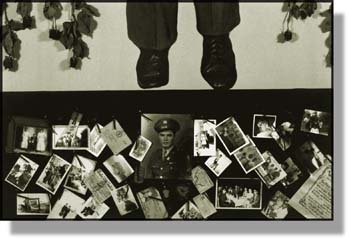
Phil Caruso
Snapshots of the Past: Joe Bastida Rodriguez's mixed-media installation "In the Name of My Father."
Plugging into personal pasts
at Euphrat Museum
By Ann Elliott Sherman
ABOUT AS FAR as you can get from the reflexive chant of "family values" stenciled on conservative campaigners' lips, Families: Rebuilding, Reinventing, Recreating, now on view at the Euphrat Museum, goes beyond rhetoric to explore the myriad ways artists incorporate different ideas and definitions of family ties into their work and lives.
Such a conceptual thesaurus is, by design, a very mixed bag. Generally, the most compelling and thought-provoking pieces touch upon a personal loss of kin, while those centered around a deliberate reinvention of family feel a bit strained or just fail to involve the rest of us.
Several of the pieces that have previously appeared at other South Bay venues here lose a bit of punch in the closer quarters of the Euphrat, most notably Joe Bastida Rodriguez's In the Name of My Father, which really needs to be hung higher than the room's dimensions allow in order for its large-scale painting to simulate an altarpiece as intended.
Bayanihan Transition would feel plucked from its context in any gallery. Named for a Filipino custom where friends and family help carry a farmer's home from place to place during the migratory growing season, the public art project was designed by DIWA Arts, a coalition of Filipino-American artists, to foster the notion of community as extended family.
So, the Studs TerkelmeetsJenny Holzer lightboards that stream excerpts from interviews with reminiscing Filipino community members were originally placed in popular hangouts and airport terminals--places where folks long established here might run into recent Filipino immigrants. While their inclusion in the show expands the survey, the communal experience of reading along with others in the extended family--so key to the public works' resonance with their previous environments--is absent.
Johnny Coleman's coming-of-age installation, however, supplies its own context. Storyteller: For Beulah's Youngest works like a theater set, poetically conjuring the garage where his father imparted the art of patching a bike tire.
A wood-framed wall is set in front of a portion of museum wall that has been stenciled to resemble plaster reinforced with chicken wire. Details like Mason jars full of rusty hardware, newspapers tidily bundled with string and old neckties tell us more about how Coleman was raised as we sit in the tire-ringed chair placed before the elegiac memorial and listen with ancient headphones to the lesson in self-reliance.
At seated eye-level on the shrine is a cross fashioned out of a bit of 2-by-4 and the spine of a book titled Among the Missing. The cross is flanked by the prints of two outstretched hands to create a mixture of benediction and reaching out to touch what is no longer there.
Flo Oy Wong contributes several works referring to the possibilities of a chosen family. The collaborative Art Family/Dinner Party includes, among other contributions to the "potluck," Terry Acebo Davis' fun dollop of dished morsels in the form of sugar cubes scripted with words both wickedly critical ("bitchy," "God awful") and warmly praising.
The Baby Jack Rice Story of Wong's husband's childhood cross-cultural friendships in the South is rather elliptically told in the artist's trademark format of rice sacks embellished with embroidery and serigraphs.
But the most fully realized piece is the collaged American Tourister turned into a book about the baggage carried by both her mother and Wong, the Lucky Daughter who "brought" the longed-for, next-born son. A case of the particular transformed into the universal, the piece manages to convey the complicated blend of pity, resentment, understanding and shock turned to resignation familiar to any survivor of revealed secrets and complicated cultural and family dynamics.
What We Mean When We Talk About Love sometimes exposes a painfully private moment, occasionally giving rise to a discomforting sense of intrusion. One or two of the more obviously allegorical nature images feel a bit stagy, but the pieces that incorporate a watery backdrop make the point of this death's connection to other natural cycles with more fruitful subtlety.
In one piece from the postmortem series In the Silence Beyond Words, Leith-Tanous marries an out-of-focus aqueous scene with seemingly spontaneous photos of her son with upstretched arms, shot from above. The unexpected perspective and the little boy's unstudied presence combine with the open-ended, fluid image to suggest a transcendent, heaven-sent reassurance of life's ongoing flow.
Families: Rebuilding, Reinventing, Recreating runs through Jan. 30 at Euphrat Museum of Art, De Anza College, Cupertino. (408/864-8836)
[ Metro | Metroactive Central | Archives ]
![[Metroactive Arts]](metroactive_files/art468.gif)